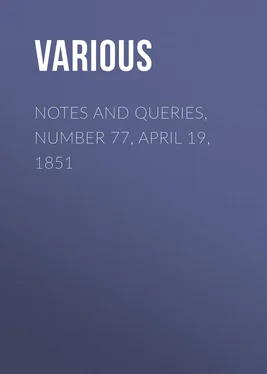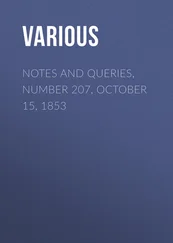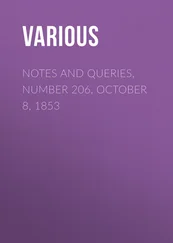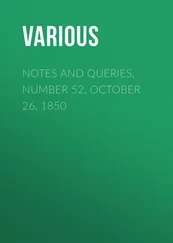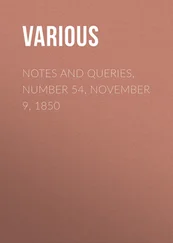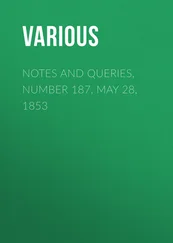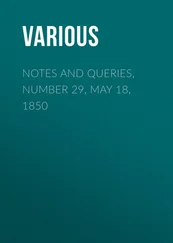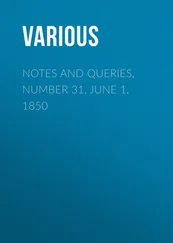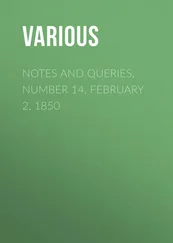Various - Notes and Queries, Number 77, April 19, 1851
Здесь есть возможность читать онлайн «Various - Notes and Queries, Number 77, April 19, 1851» — ознакомительный отрывок электронной книги совершенно бесплатно, а после прочтения отрывка купить полную версию. В некоторых случаях можно слушать аудио, скачать через торрент в формате fb2 и присутствует краткое содержание. Жанр: foreign_antique, periodic, foreign_edu, на английском языке. Описание произведения, (предисловие) а так же отзывы посетителей доступны на портале библиотеки ЛибКат.
- Название:Notes and Queries, Number 77, April 19, 1851
- Автор:
- Жанр:
- Год:неизвестен
- ISBN:нет данных
- Рейтинг книги:3 / 5. Голосов: 1
-
Избранное:Добавить в избранное
- Отзывы:
-
Ваша оценка:
- 60
- 1
- 2
- 3
- 4
- 5
Notes and Queries, Number 77, April 19, 1851: краткое содержание, описание и аннотация
Предлагаем к чтению аннотацию, описание, краткое содержание или предисловие (зависит от того, что написал сам автор книги «Notes and Queries, Number 77, April 19, 1851»). Если вы не нашли необходимую информацию о книге — напишите в комментариях, мы постараемся отыскать её.
Notes and Queries, Number 77, April 19, 1851 — читать онлайн ознакомительный отрывок
Ниже представлен текст книги, разбитый по страницам. Система сохранения места последней прочитанной страницы, позволяет с удобством читать онлайн бесплатно книгу «Notes and Queries, Number 77, April 19, 1851», без необходимости каждый раз заново искать на чём Вы остановились. Поставьте закладку, и сможете в любой момент перейти на страницу, на которой закончили чтение.
Интервал:
Закладка:
"A fellow-feeling," &c. —
"A fellow-feeling makes one wondrous kind."
This oft-quoted line is from Garrick's Epilogue on quitting the stage.
Γ.Early Instances of the World "News." —Without the slightest intention of re-opening the discussion as to whether the word "newes" be of native growth or imported, I would beg leave to suggest as a means of completing its history , that should any of the readers of "Notes and Queries," whose researches may lead amongst the authorities of the fifteenth century, meet with instances of the word in familiar use between A.D. 1400 and A.D. 1500, they would notify the same.
The earliest date of its colloquial use as yet recorded in "Notes and Queries," is A.D. 1513: on the other hand, the word, so far as I am aware, is nowhere used by Chaucer, although his near approach to it in the following lines is very remarkable:
"There is right now come into the toune a gest,
A Greek espie, and telleth newe things ,
For which I come to tell you newe tidings."
After this, the transition to the word itself is so extremely easy, that it could not be far distant.
A. E. B.Under the Rose. —It may interest the inquirers into the origin of this expression to know, that at Lullingston Castle in Kent, the residence of Sir Percival Dyke, there is in the hall an old picture, or painted carving (I forget which, as it is many years since I saw it), of a rose, some two feet in diameter, surrounded by an inscription, which, if I remember right, runs as follows, or nearly so:—
"Kentish true blue;
Take this as a token,
That what is said here
Under the rose is spoken."
It is now, or was when I saw it, in the hall of that ancient mansion, but I believe had been brought from an old house in the neighbourhood.
E. H. Y.Queries
PORTRAITS OF SPENSER
The engraved portraits of Spenser differ so much from each other as to throw doubts on their resemblance to the poet.
I have now before me the following:
1. That prefixed to Bell's edition, 1777, engraved by Cook from "an original in Lord Chesterfield's collection."
2. Prefixed to an edition in one volume published by Spiers, 1840.
3. Prefixed to Moxon's edition, 1845.
We are not told from what paintings Nos. 2. and 3. are engraved, but they resemble each other, and are somewhat like that in Bell's edition; so I shall set these three down as forming one class of portraits. No. 2. has, however, a curious inscription, Edmund Spenser , obiit 1559 , which would lead us to reject it altogether, and look on it as an imaginary likeness.
4. The portrait in Pickering's Aldine edition, 1839: this bears no resemblance, either in costume or features, to those already mentioned; but, if I mistake not, is like that in Todd's edition, published in 1805,—we may call these a second class.
An original portrait of Spenser is said to be in Lord Chesterfield's collection; another in Duplin Castle, the seat of Lord Kinnoul (of this there is a copy at Althorpe by Sir Henry Raeburn). Mr. Wright, in his Memorials of Cambridge , mentions a portrait at Pembroke College, "a copy by Wilson," but he does not say from what original: Mr. Craik, in Spenser and his Writings , speaks of two as being in this college.
The writer thinks he recollects a law-suit relative to a portrait of the poet, which had been sold to the late Sir Robert Peel, and which was stated to have come from Ireland. Perhaps some of your readers could give information respecting this picture.
It is clear, if the first three are all from the Chesterfield original, that this painting, and the one from which Mr. Pickering's is taken, cannot both be portraits of Spenser. The object of this Query is to ascertain, if possible, which engraving, or class of engravings, resembles the poet.
E. M. B.THE VENDACE
The very remarkable fish called the Vendace is to be found but in one place in the three kingdoms,—the Castle Loch of Lochmaben, a parish to the south of Dumfriesshire in Scotland. The Vendace, it is said, derives its name from Vendois in France, and was brought to this country by one of the James's. This, however, is mere conjecture, and, from its habits, highly improbable—because they die the moment they are either touched or exposed to the air .
According to Mr. Stewart ( Elements of Natural Hist. ), the Vendace belongs to a species which he calls Salmo albula , or the "Juvangis."
"This species," he adds, "is found in Lochmaben in Scotland, and nowhere else : it is said to have been carried thither from England in the time of Robert the Bruce."
Mr. Stewart describes the fish, but from his description it is evident he has never seen it. The following one is exact:—
"This beautiful fish measures from four to six inches in length, and tapers gradually to the tail. When taken out of the water, it has a bright silvery white appearance, with a slight tendency to a light blue along the back and part of the sides. In size it resembles a small herring or par, but particularly the former, not only in the mouth and external appearance, but also in the anatomical structure. Upon the top of the head
Конец ознакомительного фрагмента.
Текст предоставлен ООО «ЛитРес».
Прочитайте эту книгу целиком, на ЛитРес.
Безопасно оплатить книгу можно банковской картой Visa, MasterCard, Maestro, со счета мобильного телефона, с платежного терминала, в салоне МТС или Связной, через PayPal, WebMoney, Яндекс.Деньги, QIWI Кошелек, бонусными картами или другим удобным Вам способом.
1
Southey was not aware that the whole of Chaucer's Poem, and the "Testament of Cressid," by Henryson, was translated by Kinaston and accompanied by a copious commentary in English, but only exists in one sole MS. The press of the Camden Society would be well employed on it.
2
In Baron von Aretin's Beytrage zur Geschichte und Literatur , vol. vii. p. 301.; but the copy, though a good text, was defective at the end.
3
[We are sure we are only expressing the opinion of the majority of our readers when we say it will be most acceptable .—Ed.]
Интервал:
Закладка:
Похожие книги на «Notes and Queries, Number 77, April 19, 1851»
Представляем Вашему вниманию похожие книги на «Notes and Queries, Number 77, April 19, 1851» списком для выбора. Мы отобрали схожую по названию и смыслу литературу в надежде предоставить читателям больше вариантов отыскать новые, интересные, ещё непрочитанные произведения.
Обсуждение, отзывы о книге «Notes and Queries, Number 77, April 19, 1851» и просто собственные мнения читателей. Оставьте ваши комментарии, напишите, что Вы думаете о произведении, его смысле или главных героях. Укажите что конкретно понравилось, а что нет, и почему Вы так считаете.
